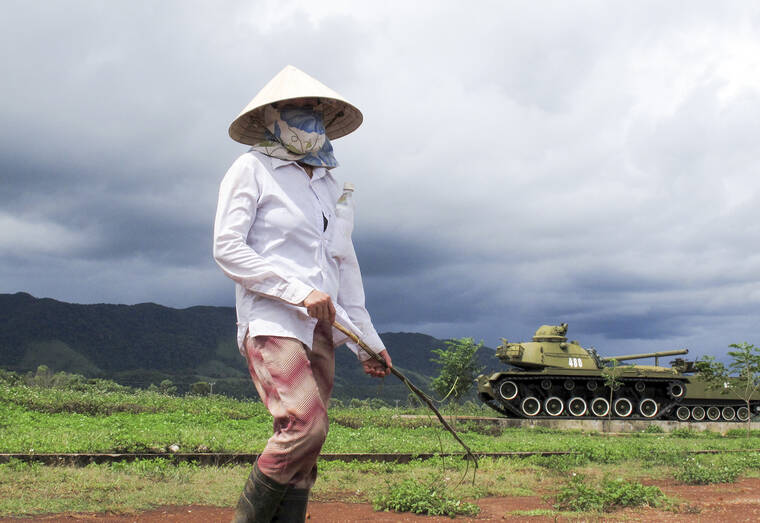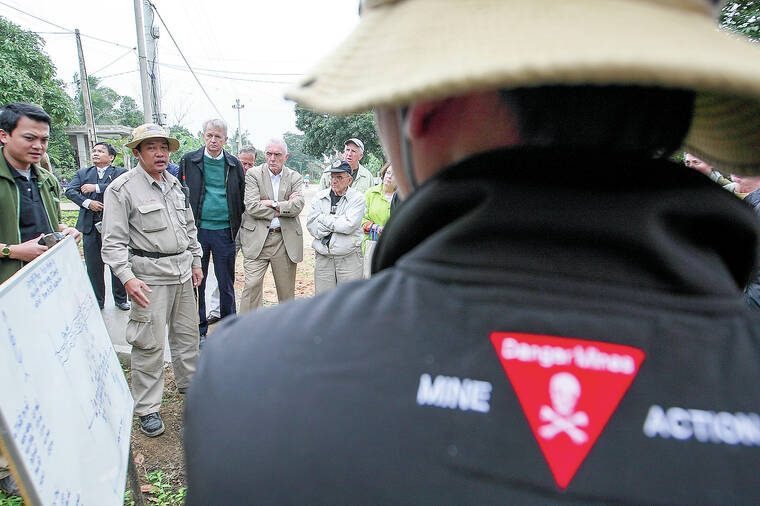An American who has helped clear 815,000 bombs from Vietnam
DONG HA, Vietnam — On a visit to the former battlefield of Khe Sanh, the scene of one of the bloodiest standoffs of the Vietnam War, the only people Chuck Searcy encountered on the broad, barren field were two young boys who led him to an unexploded rocket lying by a ditch.
One of the youngsters reached out to give the bomb a kick until Searcy cried out, “No! Stop!”
ADVERTISING
“It was my first encounter with unexploded ordnance,” Searcy said of that moment in 1992. “I had no idea that I would be dedicating my life to removing them.”
It was not Searcy’s first encounter with Vietnam. He served there as a soldier in 1968, the same year as the battle of Khe Sanh, and came away disillusioned.
As a U.S. Army intelligence analyst, he had had access to a full range of raw information, from the enemy’s body counts to exaggerated claims of American progress.
“We got to see almost everything,” he said in a recent interview. “And I saw that our friends back home were being given information that was not just misleading but deliberate lies.
“That shocked us as innocent young men,” he added, and they began to feel that the system was broken.
By the time his one-year tour of duty ended, Searcy found himself doubting not only the war but also his own character.
“I’ve really sometimes wondered if my timidity or refusal to step up and say this was wrong, whether this was a moral failure on my part,” he said. “It was a worry that made me feel that I was failing in a duty that I had as an American.”
That sense of duty has propelled him to commit his life to redressing one of the most deadly legacies of the war: the millions of unexploded bombs and land mines that continue to kill and injure people every year.
Now 79 and living in Hanoi, Searcy is perhaps the most widely known American veteran among Vietnamese, often giving local interviews and making statements that stress his anti-war views, and helping bend U.S. policies toward engagement with Vietnam.
“Chuck was one of the pioneers among the veterans in normalizing relations between the two countries,” said Hoang Nam, a senior government official in Quang Tri province who met Searcy just out of college.
Together, the two men founded Project Renew, based in Quang Tri, which since 2001 has been deploying teams of de-miners, teaching schoolchildren how to stay safe and providing prosthetics and job training to victims.
Searcy said he was often asked what motivates his commitment to the welfare of postwar Vietnam.
It is not guilt, he said. Rather, it’s a sense of responsibility to try to remedy the damage his country has caused.
The phrase he particularly embraces is a Marine Corps directive that involves clearing away spent metal shell casings on a firing range: policing up your brass.
Searcy is, both figuratively and literally, policing up the deadly ordnance that the Americans left behind throughout Vietnam.
Quang Tri province, the site of Khe Sanh and on the border with the Ho Chi Minh Trail, is just below the line that divided South and North Vietnam. It was the most heavily bombed region in Vietnam, Searcy said.
“It was kind of pointless,” he said. “They just bombed and bombed and bombed until there were no targets left. That made no sense.”
Altogether, Searcy said, almost 8 million tons of ordnance was dropped on Vietnam from 1965 to 1975. Bombs that failed to detonate became de facto land mines, which the Vietnamese government estimates have caused 100,000 deaths and injuries since the war’s end.
Since Project Renew began its work, in partnership with Norwegian People’s Aid — an organization that operates land mine-clearing operations in more than a dozen countries — the toll in Quang Tri has declined from more than 70 incidents a year to zero in 2019. Together with the Norwegians, Project Renew employs 180 de-miners.
The goal, said Nam, the co-director of Renew, is to bring the problem under control so that people can go about their lives without fear. But every day, Searcy said, his de-miners receive two or three or four reports of newly discovered ordnance.
In the last three years, two people have died in Quang Tri: a man digging a new floor in his kitchen and a boy who picked up and threw a cluster bomb.
In addition, annual flooding causes the ground to shift, making it impossible to declare an area definitively cleared of ordnance.
“It’s impossible for a province or a country to be absolutely free of bombs,” Nam said.
One victim, Ho Van Lai, 34, now works with Renew, teaching schoolchildren to identify and avoid unexploded bombs.
He was a child 24 years ago when he came across a cluster bomb, known here as a bombie, by the side of the road. “We thought they were toys to play with,” he said. “I was curious. I began banging on it with a stone. I didn’t hear the explosion, but I heard my friends screaming, and I felt hot inside.”
He lost both legs below the knee, one arm above the elbow and the sight in one eye.
After his year as an Army intelligence analyst in Vietnam, Searcy finished his military stint in Germany. Returning home to Athens, Georgia, in 1970, he said, “I was angry and confused.”
He enrolled at the University of Georgia, where he earned a bachelor’s degree in political science, joined the anti-war group Vietnam Veterans Against the War and began to speak out publicly about his views.
His father, who had fought the Germans and been imprisoned during World War II, was furious.
“We don’t know who you are anymore,” his parents told him. “What happened to you? Did they turn you into a Communist?”
But as happened to many Americans in those years, his parents’ doubts about the war gradually increased, and their views changed.
“Your mother and I have been talking,” his father told him one day months later, “and we came to the conclusion that the war is a bad thing, that you were right and we were wrong.”
Searcy and a colleague founded a weekly paper, The Athens Observer, and ran it for more than a decade. Searcy then became involved with politics, joining political campaigns and working as a U.S. Senate staff member.
In 1992, together with an Army friend, he returned to Vietnam “to see what the country looked like in peacetime.”
They spent a month on the road and found a country still suffering, cut off from international aid by a U.S. embargo and struggling in poverty under doctrinaire Communist economic strictures.
“We were amazed at the warm welcome from the Vietnamese people, who seemed to have forgiven us for the terrible pain and suffering we caused in the war,” Searcy wrote in a reminiscence published in The Vietnam Times in 2022. “I realized then I wanted to come back and find some way to help the Vietnamese people recover from the tragic war the United States had caused.”
His first chance to help came in 1995 when the Vietnam Veterans of America Foundation asked him to set up a humanitarian project to help disabled children, amputees and others who had been crippled by polio, cerebral palsy and other diseases.
When Searcy heard how many people were still being killed by unexploded bombs, he said, “my jaw dropped.”
This became his mission. He and the Norwegian group founded Renew with $500,000 in seed money from private donors.
In 2003, Searcy was awarded Vietnam’s National Friendship Medal, the highest award to a foreigner who has contributed to the country’s welfare.
In Project Renew’s two decades of operation, 815,000 bombs of all types have been detonated or taken out of action, Searcy said: aerial-dropped bombs, cluster bombs, artillery shells, booby traps, grenades and mortar rounds.
“Imagine that — 815,000,” he said. “My god!”



